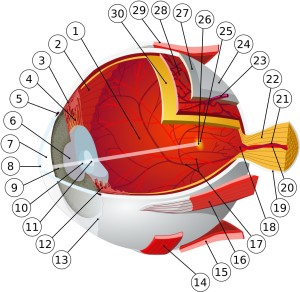 Age-related macular degeneration (ARMD) is a disease that affects central vision. It is a common cause of vision loss in people over age 60. Only the center of your vision is affected, so people rarely go blind from the disease. However, ARMD can make detailed tasks such as reading and driving difficult.
Age-related macular degeneration (ARMD) is a disease that affects central vision. It is a common cause of vision loss in people over age 60. Only the center of your vision is affected, so people rarely go blind from the disease. However, ARMD can make detailed tasks such as reading and driving difficult.
The macula is the center of the retina that contains many nerve cells. They transform light into signals that tell the brain what you are seeing. There are 2 forms of ARMD-dry and wet. Dry ARMD affects 90% of those with the disease and its cause is unknown. Slowly the light sensitive cells within the macula break down and less of the macula functions.
Wet ARMD is responsible for severe vision loss from the disease. It occurs when new blood vessels under the retina start growing toward the macula. These new vessels tend to be fragile and often leak blood and fluid under the macula. This causes rapid damage and leads to central vision loss.
Risk Factors
People over the age of 75 have a 30% risk of developing ARMD. Smoking and family history have both been linked to increased risk. Visual symptoms include blurred or distorted vision.
Treatment
Currently, dry ARMD cannot be treated. Wet ARMD is usually treated with a conventional laser applied to the blood vessels. Some cases of wet ARMD can be treated with a new procedure called photodynamic therapy. This involves injecting a dye called visudyne into the bloodstream. This special drug is activated by a laser beam, which causes the blood vessels to shrink. It is important to realize that any laser therapy is not a cure but a treatment to help stop further vision loss. The risk of new blood vessels growing back is relatively high.
New research in the Age-Related Eye Disease Study (AREDS) has shown high levels of anti-oxidants and zinc can lower the risk of advanced ARMD by 25%. These same nutrients can also reduce the risk of vision loss by 19%. People who are at high risk for developing the advanced form of ARMD should consider taking the formulation recommended by the AREDS study.
In other studies, Lutein and Zeaxanthin, which is a carotenoid plant substance that is found in the macular pigment, have also been linked to decreasing the risk of developing ARMD in the non-advanced form. These substances can be found naturally in dark green leafy vegetables and in dietary supplements. We advise a dilated eye examination and discussion with our doctors before choosing a dietery supplement to help identify your risk characteristics. Your family physician should be contacted to insure these supplements will not interfere with other medications or systemic conditions you may have.
